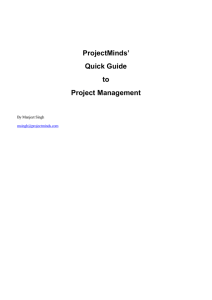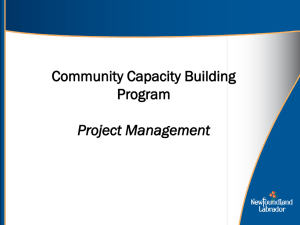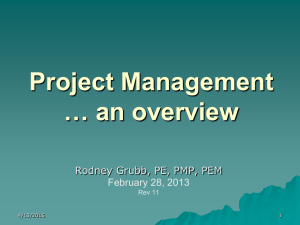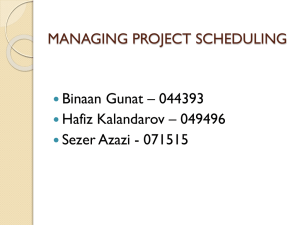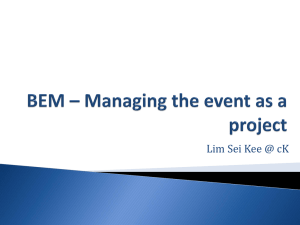Session 5
advertisement
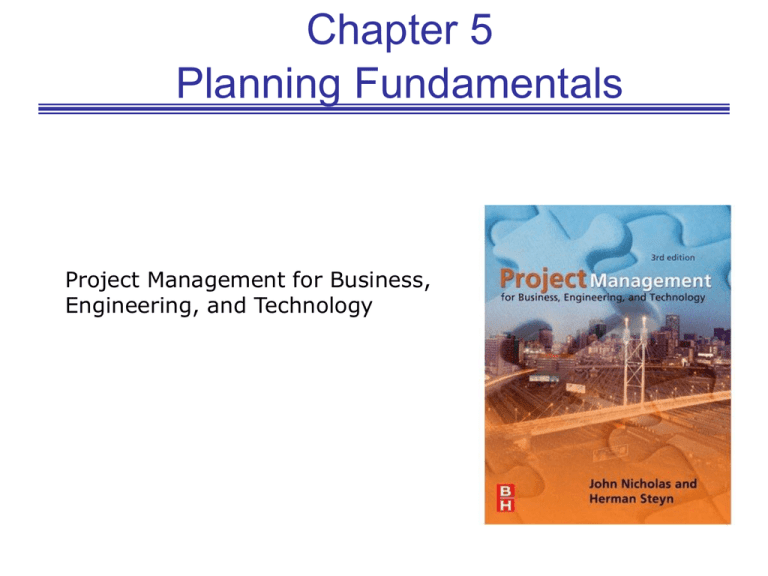
Chapter 5 Planning Fundamentals Project Management for Business, Engineering, and Technology Common Elements of Project Plan 1. Scope Statement, Charter, SOW 2. Detailed requirements 3. Project organization and responsibility for tasks 4. Detailed work definition (WBS or PBS and work package/work task details) 5. Detailed schedules with milestones 6. Project budget and cost accounts 7. Quality plan Elements of Project Plan 8. Risk plan 9. Work review plan 10.Testing plan 11.Change control plan 12.Documentation plan 13.Procurement plan 14.Implementation plan Scope, Charter, and SOW • Scope, charter, or SOW: Is the first item on project master plan. Variations on same theme • Purpose – provide broad description of master plan/project to stakeholders – directed at core project team, project organization, primary stakeholders • Is also included in RFP Defining the SOW 1. For contracted project work – Contractor and customer agree on definition of work required, work proposed, and basis for costs, schedules, and related matters. – There are two SOWs, • SOW in master plan • – – SOW in contract (CSOW) SOW in contractor’s project plan must contain same information and requirements as stated in CSOW. Contractor’s SOW and CSOW might be worded differently, but both should have exact same interpretation in terms of work and end results Defining the SOW 2. Suggestions – Ensure that SOW and WBS correspond to each other. Both must be clear; neither contractor nor customer question what has to be done. – Requirements for every end-item, task, and report must be clear enough so parties responsible will be able to sign-off acceptance of results. – Never specify tasks using “as necessary” or “as required”. • Where judgments must be made, specify who will make them, procedures for making them, and potential impact of judgments on cost and schedule escalation. Issues in Defining SOW 2. Suggestions: – Specify requirements using active terminology (“shall” or “will”) – Never use passive terminology (“should” or “try to”). – “shall” = must do – “will” = desirable to do Charter • Charter is the scope document internal projects – May include everything in Scope Statement plus • • • • risk limits customer needs spending limits key players on project team. – Issued by senior management to legitimize project – Gives project manager authority to initiate work and apply resources to project. Charter Contents • • • • • • • • • • • Background Project Objectives Scope or SOW Deliverables Assumptions Constraints Approach Schedule Project Team Risk Management Plan Work Definition • Start with the SOW and requirements (the “what” of the project) • Ask “how” will the SOW and requirements be met: what is the actual work to be performed to meet the requirements? • Subdivide the project into small, well defined work packages • Use the Work Breakdown Structure, WBS (a.k.a. Project Breakdown Structure, PBS) WBS Example for House HOUSE LIVING UNIT SITE - Excavation Foundation Plumbing Floor Carpentry OVERHEAD/ ADMINISTRATION GARAGE - Survey Storm drains Grading Walks, drive Landscaping BASEMENT - Requirements: … - INTERIOR STRUCTURE FLOOR - Frame - Subfloor, floor - Insulation ROOF - Frame Roofing Insulation Gutters WALLS - Frame Bricks Rough Wiring … - Heating - Plastering - Plumbing -Wiring --Carpentry -Painting WBS Procedure • Start with SOW and requirements • Ask “what 5-10 high level activities would yield intended results?” • For each high-level activity ask “What is involved here, what is required?” • Questions that are difficult to answer require the activity to be further broken down • Continue breaking down activities until all activities at bottom of WBS are well-defined WBS Procedure • Work Package contains: – Clear definition of work and all subtasks – Time estimates or deadlines – Cost estimates – Responsibility – Immediate predecessors, preconditions, inputs – Deliverables – Resources – Risk assessment Work Package Definition While going through WBS, ask following questions about each work package: 1. Do you need better estimates of duration and cost of the work package? 2. Can you identify who will be responsible for work the package? 3. Is the size of work package too large to track and control? 4. Are activities within work package independent of each other? 5. Do some activities within work package have different immediate predecessors? 6. Are risky and non-risky activities combined in the same work package? 7. Does the work package contain many different kinds of resources? If answer is yes to any of questions, decompose the work package into smaller work packages. If answer is no to all of them, the work package probably does not need to be subdivided. Creating WBS • Project team – Brainstorm – Past experience – Templates • Multiple teams • Experts Approaches End-item Sub-systems Approach Start with THE end-item system, subdivide it first into subsystems, then into components, then parts SD 1 Planning System SD Syscom Drives Project SD2 Control System SD 3 Office Addition SD 1.1 System Engineering SD 2.1 System Engineering SD 3.1 Design SD 1.2 Hardware SD 2.2 Software SD 3.2 Foundation SD 1.3 Software SD 2.3 Materials SD 3.3 Structure SD 2.3.1 Controllers SD 3.4 Exterior SD 2.3.2 Processors SD 3.5 Mechanical Systems SD 3.6 Interior Detail Approaches http://www.hyperthot.com/pm_wbs.htm End-item Sub-systems Approach Approaches Process-Steps Approach Start by defining phases or stages in project, then subdivide each into detailed tasks; Software development end with defined deliverables for each project 1 Level Major phases: 2 Level Activities: 3 Level Activities: Outputs: Analysis Define user interface Define application architecture Design Construct Test Rollout Develop technical design Establish quality requirements Develop detailed design Define processing flow Design logical Database structure Design system interfaces Deliverables of Phase Technical Design Document Application architecture Application flow Database design End user interface design Workflow diagram User documentation outline • WBS Formats SD Syscom Drives Project Tree Structure SD 1 Planning System • Indented Structure SD2 Control System SD 3 Office Addition SD 1.1 System Engineering SD 2.1 System Engineering SD 3.1 Design SD 1.2 Hardware SD 2.2 Software SD 3.2 Foundation SD 1.3 Software SD 2.3 Materials SD 3.3 Structure SD 2.3.1 Controllers SD 3.4 Exterior SD 2.3.2 Processors SD 3.5 MechanicalSystems SD 3.6 Interior Detail System Subsystem Component Part SD System Drives and Spaces SD1 Planning System SD1.1 System Engineering SD 1.1.1 Control requirements SD 1.1.2 Controller specifications SD 1.1.3 Controller functions SD1.2 Materials SD1.2.1 Controller devices SD1.2.2 Controller interfaces SD2 Control System Boston’s Big Dig End-item Sub-systems Approach Cambridge • Big-Dig work packages based on contracts Charles River • Contracts based on a breakdown of project into physical sections and components Downtown Boston Logan Airport Boston Harbor Every task or work package has a unique identifier SD Syscom Drives Project SD 1 Planning System SD2 Control System SD 3 Office Addition SD 1.1 System Engineering SD 2.1 System Engineering SD 3.1 Design SD 1.2 Hardware SD 2.2 Software SD 3.2 Foundation SD 1.3 Software SD 2.3 Materials SD 3.3 Structure SD 2.3.1 Controllers SD 3.4 Exterior SD 2.3.2 Processors SD 3.5 MechanicalSystems Use same identifiers on all project documents • Schedules • Budgets • Responsibility matrix • Change requests, etc. SD 3.6 Interior Detail WBS and Integrated Planning and The WBS process and work packages provide integrated plan and control: Control 1. Functional managers, subcontractors, and others responsible for the work are identified and become involved during the WBS process. 2. Work packages in each phase are logically and physically related to those in earlier and later phases; predecessor requirements are met and no steps overlooked. 3. Work packages are the basis for budgets and schedules. The project budget is the sum of the budgets for all the work packages plus project overhead and indirect expenses. The project schedule is the composite of the schedules of all the work packages. 4. The project organization is formed around work packages. Resources are assembled for and management responsibility delegated to individuals in each work package. 5. The project is directed by directing people working in individual work packages. 6. Project control is exercised through control of work packages. An integrated project plan is a systems approach to management Project Responsibility • While creating WBS, the questions “who is needed to do this” and “who will be responsible” are addressed for each package • Answers result in responsibility assignments for all areas of project • People responsible for areas of project, and details of that responsibility, are documented and communicated in Responsibility Matrix Responsibility Matrix • For each task, show who is responsible • For each person, show kind of responsibility; e.g. – P: primary or lead • One, and only one, P per task – S: secondary – N: notification required – A: approval required Responsibility Matrix Responsibility Matrix Task Al Submit Proposal Bush Travel Jon Stu All S P NSF Matching P S Boeing Match S P Curriculum P S Time Line Task All Submit Proposal Stu, Al Bush Travel Jon, Stu NSF Matching Stu, Jon Boeing Match Al, Jon Curriculum Aug Sep Oct Nov Dec Jan Scheduling Basics • WBS provides information necessary to create a schedule • Includes – List of tasks (work packages) – For each task • Duration (or target completion date) • Resources required • Inputs, preconditions, prior completed tasks (Logical sequencing) Logical Sequencing of Tasks • Predecessor: A task that must be completed before another can be started • If task C depends upon Tasks A and B, then Tasks A and B are “predecessors” for Task C. A C B Task C is the “successor” of Tasks A and B Gantt Chart • Simple, common scheduling tool • Easy to create and understand • Developed by Henry Gantt, a consultant of Frederick Taylor. H. Gannt • From Wikipedia Henry Laurence Gantt, A.B., M.E. (1861-1919) was a mechanical engineer and management consultant who is most famous for developing the Gantt chart in the 1910s. These Gantt charts were employed on major infrastructure projects including the Hoover Dam and Interstate highway system and still are an important tool in project management. Gantt Chart • Example Activity Immediate Predecessors Time A -- 1 B A 2 C B 3 D B 1 E C, D 2 F E 3 Gantt Chart A Activity Immediate Predecesso rs Time A -- 1 B A 2 C B 3 D B 1 E C, D 2 F E 3 B C D E F 1 3 4 6 Time 8 11 Gantt Chart • Another Example Activity Immediate Predecessors Time A -- 1 B -- 3 C A 2 D A 7 E B, C, D 2 F B, C, D 3 G E 6 H F 1 Activity Immediate Predecessor s Time A -- 1 B -- 3 C A 2 D A 7 B E B, C, D 2 C F B, C, D 3 G E 6 H F 1 Gantt Chart A Tasks D E F G H 1 3 8 Time 10 11 12 16 Level of Detail • Level of detail should reflect audience • Example Foundation Top Management (low-level detail) Project Manager Excavate Footings Basement Walls Site Manager (high-level detail) Forms Reinforce Strip Structure Level of Detail Gantt Chart: Pro and Con • Pro: Easy to construct and understand • Con: does not necessarily indicate relationships among tasks, so is limited as tool for planning and control. A B C Tasks D E F G H 1 3 8 Time 10 11 12 Time 16 Gantt Chart: Pro and Con What is effect of – C starting 2 weeks late? – E taking 3 weeks instead of 2 weeks? – E finishing a week early? A B C Tasks D E F G H 1 3 8 Time 10 11 12 16 Gantt Chart: Pro and Con • With simple Gantt charts, such questions are not always easy to answer. • Yet you need the answers to plan the project and create realistic schedules • Gantt charts are good for displaying schedules, – Networks, described in the next chapter, are better for creating them Line of Balance • Used in projects that require a number of identical units, where each unit involves a number of steps. • The method enables tracking progress of the units and identifying situations where progress is behind or ahead of schedule Line of Balance • Example: a project requires 80 units of an item. • Each unit involves 4 steps: it must be produced, tested, installed, than tested again. It takes 5 weeks to complete all the steps. • The completion of each unit is marked by a milestone A = production B = test C= installation D = final test Line of Balance Production = 4 weeks Test = 1 week A B Final test = 1 week Installation = 2 weeks C D As shown, completion of each unit is marked by a milestone A = production B = test C= installation D = final test Based on other requirements and available resources, the project schedule specifies that the following number of units must be completed (i.e., reached milestone D) by the following dates: units completed week 20 10 30 11 10 12 20 13 Line of Balance Looking only at the first 20 units to be completed in week 10, the time by when these units should have reached the other milestones is shown below Production = 4 weeks Test = 1 week Final test = 1 week Installation = 2 weeks A B C D initial 20 units: week 6 7 9 10 The times by when the others should reach the milestones is: A B C D 30 7 8 10 11 10 8 9 11 12 20 9 10 12 13 Line of Balance The total number of units that should have passed milestone D as of week 13 is 80. However, for tracking purposes, the number of units that should have passed any of the milestones anytime before week 13 can be represented on a graph. The graph below shows number of units that should have passed each milestone by the end of week 9. Units A 20 week 6 30 7 10 8 20 9 80 70 60 50 40 LOB 80 60 30 20 20 10 0 Milestone A B C D B 7 8 9 10 C 9 10 11 12 D 10 11 12 13 Line of Balance This graph shows number of units that should have passed each milestone by the end of week 10. Units A 20 week 6 30 7 10 8 20 9 80 70 60 80 80 30 50 20 20 10 0 Milestone C 9 10 11 12 D 10 11 12 13 LOB 50 40 B 7 8 9 10 A B C D The LOB is used to track progress. Each week the number of units that actually passed each milestone is compared to the LOB. Whenever actual units that passed a milestone falls below the LOB, the work is behind schedule. Procurement Management Procurement management • The planning, budgeting, scheduling, and control of procured goods, work, or services (GWS). • Usually, goods are raw materials or produced items, work is contracted labor, and services is consulting Procurement Management Includes • Equipment, materials, or components designed and provided by vendors specifically for the project. Could be: – portions of work packages or entire work packages (e.g., design work, environmental impact study, soil analysis) – major portions of the project wholly (“turnkey”: subcontractors fully design, build, and install equipment or components for the project enditem). • • Off-the-shelf (OTS) equipment and components supplied by vendors. (Products readily available and not specifically produced for the project.) Bulk materials (cement, metal tubing or framing, wire, stone, piping, etc.) • Consumables (nails, bolts, rivets, fuel) or loose tools used for construction or fabrication • Equipment not already owned by the contractor; e.g., includes cranes, supports, scaffolding, and equipment for machine-shops, welding, and testing. • Administrative equipment not already owned by contractor; e.g., computers, project office facilities and office equipment. Procurement Management Indentifying GWS items to be procured Involves decision about which items are to be designed/built/ provided in-house and which to be procured (purchased or acquired) Happens during the WBS process or design process when the needed materials and resources are first identified. Procurement Management Involves Contracting with suppliers or subcontractors, often through the formal RFP/proposal process. Integrating procured GWS items into the project life cycle and project plan (i.e., schedule, responsibility matrix, budget, quality, and risk, etc.) Logistics Transport and storage of materials for the project. loading, unloading, transportation, inspection, clearances and approvals, and storage of materials can be major issues. Procured materials must arrive when needed according to project schedules.

